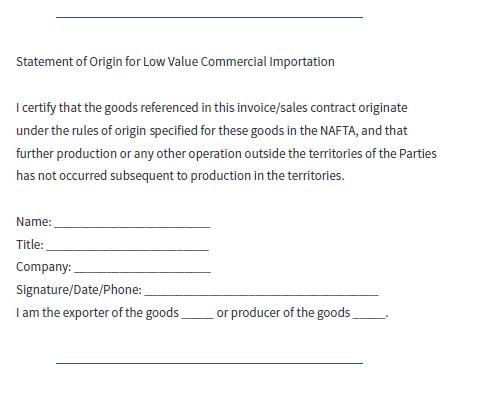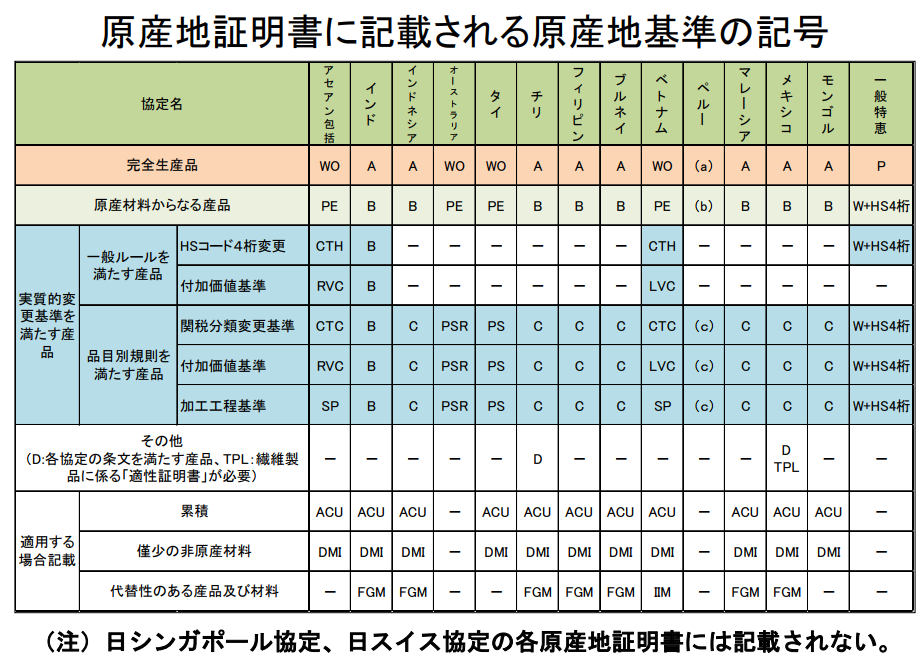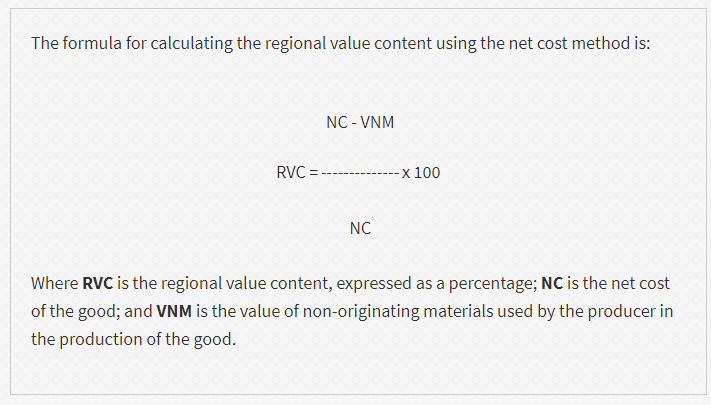USMCA(旧NAFTA)(北米自由貿易協定、North American Free Trade Agreement)は、
アメリカ合衆国、カナダ、メキシコによる自由貿易協定であり
この3か国間における貿易においては特恵関税率が適用され、
特恵関税率の適用によって関税の撤廃あるいは削減がされます。
特恵関税率が適用されるには各締約国での原産品である事の証明が必要であり、
その為には締約国での輸入通関の際、「原産地証明書」の提出が必要となります。
自己証明制度による原産地証明書
USMCAで使用される原産地証明書は「自己証明制度」が採用されており、
商工会議所等第三者機関が作成するものではなく製造者、輸出者自身が
作成する必要があります。
原産地証明書が不要なケース
貨物の価格によっては原産地証明書を必要としない場合もあります。
価格の基準は各国によって異なります。
■アメリカで輸入の場合USD 2,500未満
■カナダでの輸入の場合CAD 1,600 未満
■メキシコでの輸入の場合USD 1,000未満
但し、その際は特恵関税の適用対象である旨を宣誓した
生産者、輸出者による説明書が添付されている必要があります。
■USMCA原産地証明書提出除外の為の宣誓書例

USMCA原産地証明書記入要領
1欄-Exporter Name and Address
輸出者の名称と住所
※Legal tax identification numberについて
-For US exporters/importers, this number is the employer identification
number assigned by the Internal Revenue Service. If you don’t have such a
number, you may use your social security number.
-For Canadian exporters/importers, use the employer number assigned by
Revenue Canada or, if not available, the importer/exporter number assigned
by Canada Customs.
-For Mexican exporters/importers, use the federal taxpayer’s registry number
2欄-Blanket Period
複数回の通関に包括的に使用する場合は“From”から初めて
1年以内の期間を定める
Complete Field 2 if the certificate covers multiple shipments of identical goods
described in Field 5 that are imported into a NAFTA country for a specified
period of up to one year (blanket period). “From” is the date upon which the
certificate becomes applicable to the good covered by the blanket, and it may
be prior to the date of signing this certificate.
3欄-Producer Name and Address
製造者の名称、住所、legal taxidentification number を記載
もし製造者名を輸入者に知られたくない場合は
“Available to Customs Upon Request.”と記載する事が可能
4欄-Importer Name and Address
輸入者の名称、住所、legal taxidentification number
原産地証明書だけが作成され、輸入者が未確定の場合は“unknown.”とし、
輸入者が複数いる場合は“various.”と記載する事が可能
5欄-Description of Good
貨物の名称
※輸出者の責任においてインボイスや申告するHSコードに一致させる
6欄-HS Tariff Classification Number
貨物の該当するHSコードを記載する
基本はHS6桁の記載になりますがNAFTA General Note 12に該当する場合
8桁を要する場合もあります。
7欄-Preference Criteria
原産地記号を記載する
原産地記号とはどのような工程を経てNAFTA原産とみなすかを表します。
日本が締結しているFTA/EPAには以下のような記号を使用します。
※USMCAはこの一覧には含まれません

USMCAの場合は「Preference Criterion A ~ E」で原産地記号を表します。
Preference Criterion A
■USMCAで製造された完全生産品(WOと同じ)
Preference Criterion A corresponds to goods wholly obtained or produced entirely in Canada, Mexico, or the United States.
For a good to qualify under this criterion, it must contain no non-North American parts or materials anywhere in the production process. It is generally reserved for basic products such as those harvested, mined, or fished in the NAFTA territory, although it would include a manufactured good with no non-NAFTA inputs.
As a general rule, however, Preference Criterion A rarely applies to manufactured goods. If the good contains any non-NAFTA materials, it will not qualify under Preference Criterion A.
Preference Criterion B
■実質的変更基準(原産地規則)を満たしUSMCA原産として見なすもの
(PSと同じ)
Even if your good contains non-NAFTA materials, it can qualify as B if the materials satisfy the Rules of Origin. The Annex 401 Rules of Origin are based on a change in tariff classification, a regional value-content requirement, or both.
The updated Rules of Origin are located in HTSUS General Note 12(t) of the NAFTA. Agreement. Preference Criterion B is used when the good being certified is produced using materials that the producer/exporter is unable to prove qualify as originating goods in their own right. The finished product will be originating if the requirements of the applicable rule of origin are met. The requirements of the NAFTA Rules of Origin differ from good to good.
Preference Criterion C
■原産材料からなる産品、原産材料を辿っていけばどこかで第三国原料が
あるが基本的には完全生産品であるもの(PEと同じ)
This criterion corresponds to goods produced entirely in Canada, Mexico, and/or the United States exclusively from NAFTA materials.
Preference Criterion C is used when the producer/exporter is able to document that the finished good is produced entirely in the NAFTA territory using only materials that would qualify in their own right. The producer/exporter should have documented proof that every raw material and component is a NAFTA good.
Preference Criterion D
分解された状態の貨物でパーツとしてのHS分類をすると原産地規則Annex401を
満たさないが、RVC(付加価値基準)は満たしている
Unassembled goods and goods classified in the same Harmonized System number as their parts, which do not meet the Annex 401 rule of origin (tariff shift), but contain sufficient North American regional value content qualify as originating.
In a very few cases a good that has not undergone the required tariff transformation can still qualify for preferential NAFTA treatment if a regional value content requirement is met.
Preference Criterion E
NAFTA Annex308.1に該当する貨物
This criterion applies to certain automatic data processing goods
and their parts, specified in Annex 308.1.
Preference Criterion F
アメリカからメキシコに輸出される特定農産物
Preference Criterion F concerns specific agricultural goods that are exported from the U.S. into Mexico. For further information, you can contact the Bilateral and Enforcement Division of the Foreign Agricultural Service at the U.S. Department of Agriculture at 202-720-3798.
8欄-Producer
製造者名、輸出者自身が製造者でない場合に記載する
9欄-Net Cost
原産地規則を満たすためにネットコストから算出した価格にて
RVC(付加価値基準)を基準にしている場合は”NC”と記載し、
それ以外の方法で原産地規則を満たしていれば”no”と記載
※ネットコストとは産品価格から経費を引いたもの
例えば広告費、マーケティング費用、アフターサービス料、ロイヤリティ
船賃、梱包、金利等
■ネットコスト計算式
(RVC=付加価値、NC=ネットコスト、VNM=非原産材料費)
詳しい計算例はUSMCAのRVC計算方法を参考にしてください。

10欄-Country of Origin
原産国名を記載する
カナダ向けの輸出であれば“MX” や “US”を記載する
For all other originating goods exported to Canada, indicate appropriately
“MX” or “US” if the goods originate in that NAFTA country, within the meaning
of Annex 302.2 and any subsequent processing in the other NAFTA country
does not increase the transaction value of the goods by more than seven
percent; otherwise indicate “JNT” for joint production.
11欄-Contact Information
11欄は輸出者による日付とサインが必要です。
原産地証明書が製造者によって作成され、輸出者が使用するケースであれば
日付とサインは製造者が行う事もできます。
日付は原産地証明書を作成した日になります。
税関が質問をする際には11欄に記載されている者に対して行われますので
適切な回答をできる方の名前が必要となります。